#Place de Saint Michel
Text





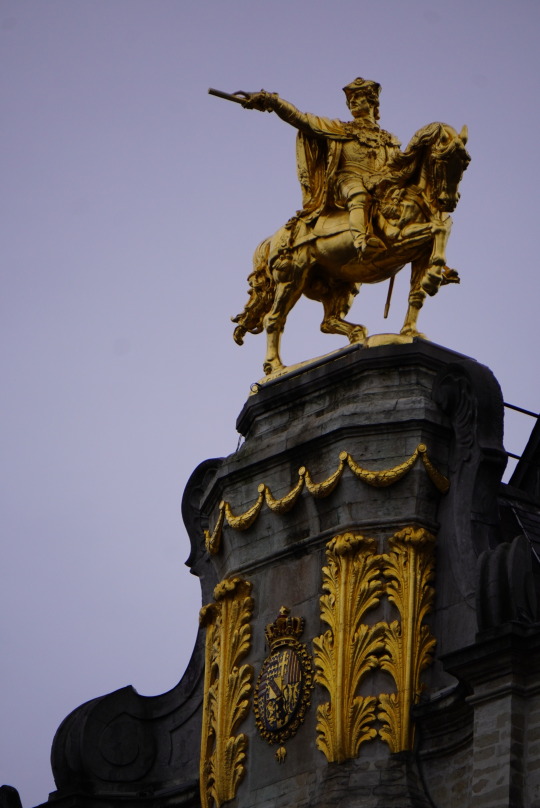








Details of Brussels, captured through the lense of my friend R., a first-time visitor. 🏙️
#BXL#Bruxelles ma belle#posted w/ permission#musées royaux d'art et d'histoire#grand-place#église saint-catherine#palais royal de bruxelles#Cathédrale Saints-Michel-et-Gudule de Bruxelles#Basilique du Sacré-Cœur de Bruxelles#Brussels#Belgium
4 notes
·
View notes
Text
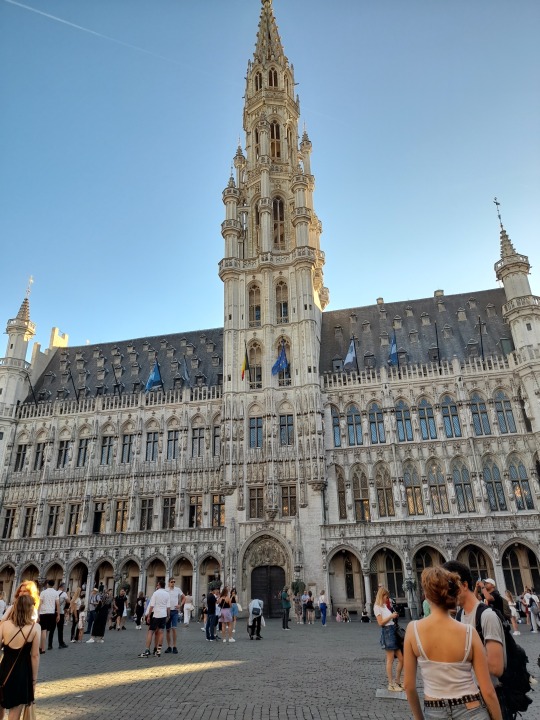


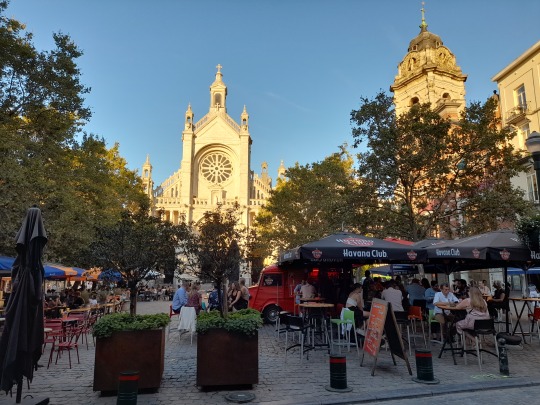



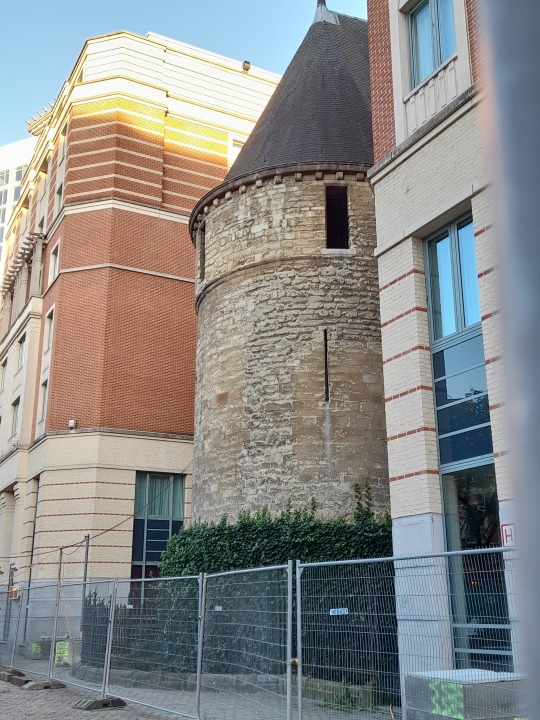
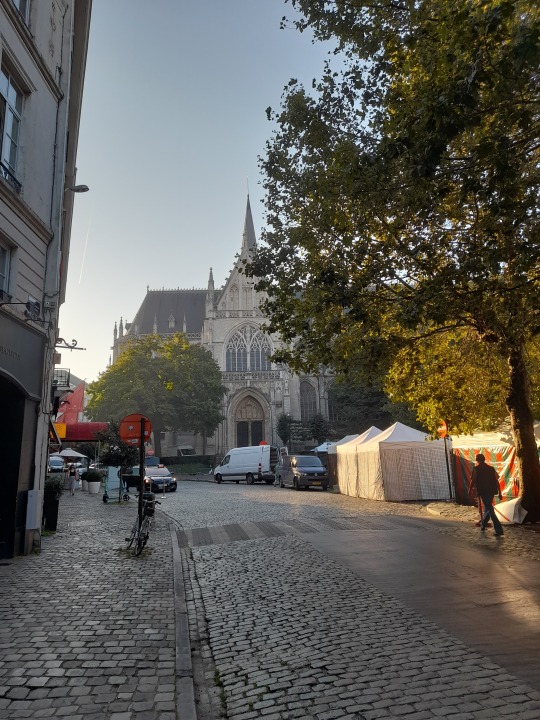
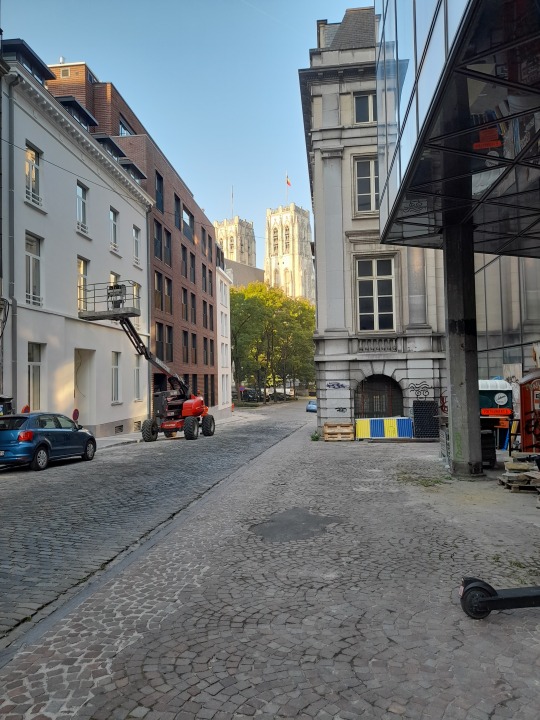
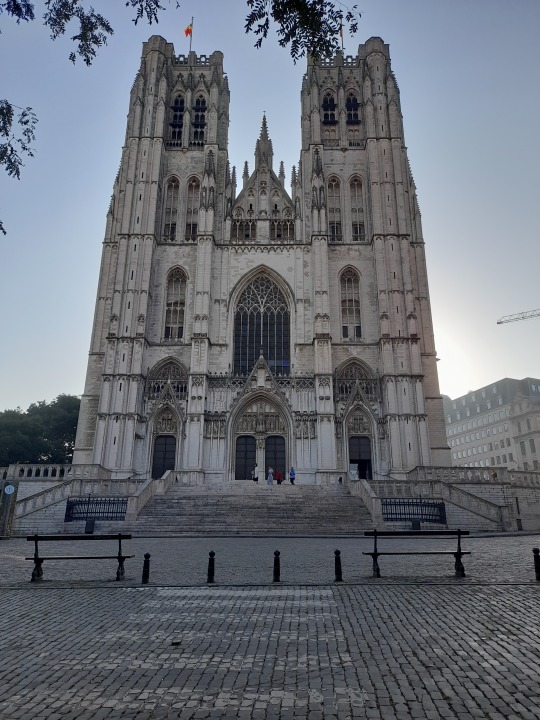
Églises. Grand-Place. (Bruxelles 2023)
#travel#voyage#brussels#bruxelles#belgium#belgique#no filter#grand-place#hotel de ville#town hall#église#church#église sainte-catherine#bourse de bruxelles#porte de hal#tour noire#notre-dame de la chapelle#cathédrale saints-michel-et-gudule
0 notes
Text

Le Petit écho de la mode, no. 21, vol. 20, 22 mai 1898, Paris. 1. Toilettes pour jeunes filles ou jeunes femmes. Modèles de Mlle Thirion, 47, boulevard Saint-Michel, Paris. Ville de Paris / Bibliothèque Forney
(1.) Roue en voile "fil de la vierge" composée d’une jupe unie posée sur un fond de jupe de taffetas; et d’un corsage froncé, monté sur un empiècement plissé à plis lingerie, entouré d’une berthe formant épaulettes coupées d'entre-deux et ourlées de dentelle; plusieurs rangs de fronces retiennent l’ampleur du bas du corsage qui se termine sous une ceinture de ruban fermée par une boucle finement ciselée, col droit garni d’une ruche, manches froncées, garnies de coques de ruban. Chapeau en paille orné de tulle et de fleurs.
(1.) Wheel in “thread of the virgin” voile composed of a plain skirt placed on a taffeta skirt background; and a gathered bodice, mounted on a pleated yoke with lingerie pleats, surrounded by a berthe forming shoulder pads cut in between and hemmed with lace; several rows of gathers retain the fullness of the bottom of the bodice which ends under a ribbon belt closed by a finely crafted buckle, straight collar trimmed with a ruffle, gathered sleeves trimmed with ribbon shells. Straw hat decorated with tulle and flowers.
Matériaux: 7 mètres de voile en 1m20 de large, 6 mètres de ruban.
—
(2.) Robe en voile posée sur un fond de jupe en taffetas, ourlée de petits galons de velours noir; mêmes galons posés, à mi-jupe, en dents aiguës retenues par des nœuds de dentelle. Corsage blouse devant, composé d’un dos tendu, plissé à plis horizontaux bordés de dentelle, décolleté du haut sur un empiècement en broderie écrue posé sur un transparent de soie; et d’un devant sans pince, plissé en travers, garni de dentelle; empiècement en broderie, fermeture invisible sur le côté, ornée de nœuds de dentelle; col droit recouvert de dentelle, manches en dentelle plissées dans le haut, bordées d’un volant, ceinture en ruban fermée par une boucle. Toquet en tulle noir gracieusement drapé, relevé sur le côté gauche par deux touffes de fleurs d’où s’échappent deux plumes pailletées de jais.
(2.) Voile dress placed on a taffeta skirt, hemmed with small black velvet braids; same braids placed, mid-skirt, in sharp teeth held by lace bows. Blouse bodice in front, composed of a taut back, pleated with horizontal folds edged with lace, top neckline on an ecru embroidery yoke placed on a transparent silk; and a front without pleats, pleated across, trimmed with lace; embroidery yoke, invisible closure on the side, decorated with lace bows; straight collar covered in lace, lace sleeves pleated at the top, edged with a ruffle, ribbon belt closed with a buckle. Gracefully draped black tulle toquet, enhanced on the left side by two tufts of flowers from which two jet-glittered feathers escape.
Matériaux: 7 mètres de voile, 9 mètres d’entre-deux, 1 mètre de guipure, 1 mètre de taffetas.
Chapeaux de Mme Marchand, 96, avenue Victor-Hugo.
—
Le Sautoir Sapho que représente notre gravure est une délicieuse création parisienne; il se compose d’une chaîne en cordonnet de soie avec coulants d’acier d’un effet charmant. Cette chaîne mesure 1m50 de long, elle est destinée a retenir une montre, un face à main ou un joli crayon. C’est un objet que toutes nos lectrices voudront se procurer, étant donné sou prix minime de 2 fr. 45 franco.
The Sautoir Sapho represented by our engraving is a delicious Parisian creation; it is made up of a silk cord chain with steel slides for a charming effect. This chain measures 1.5 meters long, it is intended to hold a watch, a faceplate or a pretty pencil. It is an object that all our readers will want to obtain, given its minimal price of 2.45 francs.
#Le Petit écho de la mode#20th century#1890s#1898#on this day#May 22#periodical#fashion#fashion plate#cover#color#description#Forney#dress#flower#Modèles de chez#Mademoiselle Thirion#Madame Marchand
57 notes
·
View notes
Note
I understand the story of marat and his assassination event
But who is lepeletier?
Because I saw a drawing for him by louis David and I learned about his death which happen to be the same as Marat so yeah .. I wanna know about him.
According to the biography Michel Lepeletier de Saint-Fargeau, 1760-1793 (1913), its subject of study was born on 29 May 1760, in his family home on rue Culture-Sainte-Catherine, a building which today is the Bibliothèque Historique de la Ville de Paris. His family belonged to the distinguished part of the robe nobility. At the death of his father in 1769, Lepeletier was both Count of Saint-Fargeau, Marquis of Montjeu, Baron of Peneuze, Grand Bailiff of Gien as well as the owner of 400,000 livres de rente. For five years he worked as avocat du roi at Châtelet, before becoming councilor in Parliament in 1783, general counsel in 1784 and finally taking over the prestigious position of président à mortier at the Parlement of Paris from his father in 1785. On May 16 1789, Lepeletier was elected to represent the nobility at the Estates General. On June 25 the same year he was one of the 47 nobles to join the newly declared National Assembly, two days before the king called on the rest of the first two estates to do so as well. A month later, during the night of August 4 1789, he was in the forefront of those who proposed the suppression of feudalism, even if, for his part, this meant losing 80 000 livres de rente. Four days later he wrote a letter to the priest of Saint-Fargeau, renouncing his rights to both mills, furnaces, dovecote, exclusive hunting and fishing, insence and holy water, butchery and haulage (the last four things the Assembly hadn’t ruled on yet). When the Assembly on June 19 1790 abolished titles, orders, and other privileges of the hereditary nobility, Lepeletier made the motion that all citizens could only bear their real family name — ”The tree of aristocracy still has a branch that you forgot to cut..., I want to talk about these usurper names, this right that the nobles have arrogated to themselves exclusively to call themselves by the name of the place where they were lords. I propose that every individual must bear his last name and consequently I sign my motion: Michel Lepeletier” — and the same year he also, in the name of the Criminal Jurisprudence Committee, presented a report on the supression of the penal code and argued for the abolition of the death penalty. After the closing of the National Assembly in 1791, Lepeletier settled in Auxerre to take on the functions of president of the directory of Yonne, a position to which he had been nominated the previous year. He did however soon thereafter return to Paris, as he, following the overthrow of the monarchy, was one of few former nobles elected to the National Convention, where he was also one of even fewer former nobles to sit together with the Mountain. In December 1792 he started working on a public education plan. On January 20 1793, he voted for death without a reprieve and against an appeal to the people during the trial of Louis XVI (Opinion de L.M. Lepeletier, sur le jugement de Louis XVI, ci-devant roi des François: imprimée par ordre de la Convention nationale). After the session was over, Lepeletier went over to Palais-Égalité (former Palais-Royal) where he dined everyday. The next day, his friend and fellow deputy Nicolas Maure could report the following to the Convention:
Citizens, it is with the deepest affection and resentment of my heart that I announce to you the assassination of a representative of the people, of my dear colleague and friend Lepelletier, deputy of Yonne; committed by an infamous royalist, yesterday, at five o'clock, at the restaurateur Fevrier, in the Jardin de l'Égalité. This good citizen was accustomed to dining there (and often, after our work, we enjoyed a gentle and friendly conversation there) by a very unfortunate fate, I did not find myself there; for perhaps I could have saved his life, or shared his fate. Barely had he started his dinner when six individuals, coming out of a neighboring room, presented themselves to him. One of them, said to be Pâris, a former bodyguard, said to the others: There's that rascal Lepeletier. He answered him, with his usual gentleness: I am Lepeletier, but I am not a rascal. Paris replied: Scoundrel, did you not vote for the death of the king? Lepelletier replied: That is true, because my confidence commanded me to do so.Instantly, the assassin pulled a saber, called a lighter, from under his coat and plunged it furiously into his left side, his lower abdomen; it created a wound four inches deep and four fingers wide. The assassin escaped with the help of his accomplices. Lepeletier still had the gentleness to forgive him, to pray that no further action would be taken; his strength allowed him to make his declaration to the public officer, and to sign it. He was placed in the hands of the surgeons who took him to his brother, at Place Vendôme. I went there immediately, led by my tender friendship, and my reverence for the virtues which he practiced without ostentation: I found him on his death bed, unconscious. When he showed me his wound, he uttered only these two words: I'm cold. He died this morning, at half past one, saying that he was happy to shed his blood for the homeland; that he hoped that the sacrifice of his life would consolidate Liberty; that he died satisfied with having fulfilled his oaths.
This was the first time a Convention deputy had gotten murdered, and it naturally caused strong reactions. Already the same session when Maure had announced Lepeletier’s death, the Convention ordered the following:
There are grounds for indictment against Pâris, former king's guard, accused of the assassination of the person of Michel Lepelletier, one of the representatives of the French people, committed yesterday.
[The Convention] instructs the Provisional Executive Council to prosecute and punish the culprit and his accomplices by the most prompt measures, and to without delay hand over to its committee of decrees the copies of the minutes from the justice of the peace and the other acts containing information relating to this attack.
The Decrees and Legislation Committees will present, in tomorrow's session, the drafting of the indictment.
An address will be written to the French people, which will be sent to the 84 departments and the armies, by extraordinary couriers, to inform them of the crime against the Nation which has just been committed against the person of Michel Lepelletier, of the measures that the National Convention has taken for the punishment for this attack, to invite the citizens to peace and tranquility, and the constituted authorities to the most exact surveillance.
The entire National Convention will attend the funeral of Michel Lepelletier, assassinated for having voted for the death of the tyrant.
The honors of the French Pantheon are awarded to Michel Lepelletier, and his body will be placed there.
The president is responsible for writing, on behalf of the National Convention, to the department of Yonne, and to the family of Lepelletier.
The next day, January 22, further instructions were given regarding Lepeletier’s funeral:
On Thursday January 24, Year 2 of the Republic, at eight o'clock in the morning, will be celebrated, at the expense of the Nation, the funeral of Michel Lepeletier, deputy of the department of Yonne to the National Convention.
The National Convention will attend the funeral of Michel Lepeletier in its entirety. The executive council, the administrative and judicial bodies will attend it as well.
The executive council and the department of Paris will consult with the Committee of Public Instruction regarding the details of the funeral ceremony.
The last words spoken by Michel Lepeletier will be engraved on his tomb, they are as follows: “I am happy to shed my blood for the homeland; I hope that it will serve to consolidate Liberty and Equality; and to make their enemies recognized.”
In number 27 (January 27 1793) of Gazette Nationale ou Le Moniteur Universel, the following long description was given over Lepeletier’s funeral, held three days earlier:
The funeral of Lepeletier Saint-Fargeau was celebrated on Thursday 24 with all the splendor that the severity of the weather and the season allowed, but with such a crowd that it could have been the most beautiful day of the year. At ten o'clock in the morning his deathbed was placed on the pedestal where the equestrian statue of Louis XVI previously stood, on Place Vendôme, today Place des Piques. One went up to the pedestal by two staircases, on the banisters of which were antique candelabras. The body was lying on the bed with the bloody sheets and the sword with which he had been struck. He was naked to the waist, and his large and deep wound could be seen exposed. These were the mournful and most endearing part of this great spectacle. All that was missing was the author of the crime, chained, and beginning his torture by witnessing the sight of the triumph of Saint-Fargeau.
As soon as the National Convention and all the bodies that were to form courage were assembled in the square, mournful music was played. It was, like almost all those which has embellished our revolutionary festivals, the composition of citizen Gossec. The Convention was ranged around the pedestal. The citizen in charge of the ceremonies presented the President of the Convention with a wreath of oak and flowers; then the president, preceded by the ushers of the Convention and the national music, went around the monument, and went up to the pedestal to place the civic crown on Lepeletier's head: during this time, a federate gave a speech; the president dismounted, the procession set out in the following order: A detachment of cavalry preceded by trumpets with fourdincs. Sappers. Cannoneers without cannons. Detachment of veiled drummers. Declaration of the rights of man carried by citizens. Volunteers of the six legions, and 24 flags. Drum detachment. A banner on which was written the decree of the Convention which ordered the transport of Lepeletier's body to the Pantheon. Students of the homeland. Police commissioners. The conciliation office. Justices of the peace. Section presidents and commissioners. The commercial court. The provisional criminal court. The department’s fix courts. The electorate. The provisional criminal court. The department's criminal courts fix. The municipality of Paris. The districts of Saint-Denis and the village of L’Égalité. The Department. Drum detachment. The seal of the 84, worn by Federates. The provisional executive council. National Convention Guard Detachment. The court of cassation. Figure of Liberty carried by citizens. The bloody clothes worn at the end of a national pike, deputies marching in two columns. In the middle of the deputies was a banner where Lepeletier's last words were written: "I am happy to shed my blood for my homeland, I hope that it will serve to consolidate Liberty and Equality, and to make their enemies known.”
The body carried by citizens, as it was exhibited on the Place des Piques. Around the body, gunners, sabers in hand, accompanied by an equal number of Veterans. Music from the National Guard, who performed funeral tunes during the march. Family of the dead. Group of mothers with children. Detachment of the Convention Guard. Veiled drums. Volunteers of the six legions and 24 flags. Veiled drums. Volunteers of the six legions and 24 flags. Veiled drums. Volunteers of the six legions and 24 flags. Veiled drums. Armed federations. Popular societies. Cavalry and trumpets with fourdines. On each side, citizens, armed with pikes, formed a barrier and supported the columns. These citizens held their pikes horizontally, at hip height, from hand to hand. The procession left in this order from the Place des Piques, and passed through the streets St-Honoré, du Roule, the Pont-Neuf, the streets Thionville (former Dauphine), Fossés Saint-Germain, Liberté (former Fossés M. le Prince), Place Saint-Michel and Rue d'Enfer, Saint-Thomas, Saint-Jacques and Place du Panthéon. It stopped front of the meeting room of the Friends of Liberty and Equality; opposite the Oratory, on the Pont-Neuf, opposite the Samaritaine; in front of the meeting room of the Friends of the Rights of Man; at the intersection of Rue de la Liberté; Place Saint-Michel and the Pantheon. Arriving at the Pantheon, the body was placed on the platform prepared for it. The National Convention lined up around it; the band, placed in the rostrum, performed a superb religious choir; Lepeletier's brother then gave a speech, in which he announced that his brother had left a work, almost completed, on national education, which will soon be made public; he ended with these words: I vote, like my brother, for the death of tyrants. The representatives of the people, brought closer to the body, promised each other union, and swore on the salvation of the homeland. A big chorus to Liberty ended the ceremony.
According to Michel Lepeletier de Saint-Fargeau, 1760-1793 (1913), civic festivals in honor of Lepeletier were celebrated in all sections of Paris, as well as the towns of Arras, Toulouse, Chaumont, Valenciennes, Dijon, Abbeville and Huningue. Lepeletier’s body did however only get to rest in the Panthéon for a little more than two years, as on February 15 1795, the Convention ordered it exhumed, at the same time as that of Marat. It was instead buried in the park surrounding Château de Ménilmontant, the properly of which the ancestor Lepeletier de Souzy had purchased in the 17th century and that still remained in the family.
One day after the funeral, January 25, Lepeletier’s only child, the ten and a half year old Susanne, who had already lost her mother ten years before the murder of her father, was brought before the Convention by her step-mother and two paternal uncles Amédée and Félix. It was Félix who had held a speech during the funeral and he would continue to work for his seven years older brother’s memory afterwards too, offering a bust of him to the Convention on February 21 1793, (on the proposal of David, it was placed next to the one of Brutus), reading his posthumous work on public education to the Jacobins on July 19 1793, and even writing a whole biography over his life in 1794 (Vie de Michel Lepeletier, représentant du peuple français, assassiné à Paris le 20 janvier 1793 : faite et présentée a la Société des Jacobins).
The president announces that the widow of Michel Lepelletier, his two brothers and his daughter, request to be admitted to the bar, to testify to the Convention their recognition of the honors that they have decreed in memory of their relative. It is decreed that they will be admitted immediately.
One of Michel Lepeletier’s brothers: Citizens, allow me to introduce my niece, the daughter of Michel Lepelletier; she comes to offer you and the French people her recognition of the eternity of glory to which you have dedicated her father... He takes the young citoyenne Lepelletier in his arms, and makes her look at the president of the Convention... My niece, this is now your father... Then, addressing the members of the Convention, and the citizens present at the session: People, here is your child... Lepelletier pronounces these last words in an altered voice: silence reigns throughout the room, with exception for a couple of sobs.
The President: Citizens, the martyr of Liberty has received the just tribute of tears owed to him by the National Convention, and the just honor that his cold skin has received invites us to imitate his example and to avenge his death. But the name of Lepelletier, immortal from now on, will be dear to the French Nation. The National Convention, which needs to be consoled, finds relief to its pain in expressing to his family the just regrets of its members and the recognition of the great Nation of which it is the organ. The Nation will undoubtedly ratify the adoption of Michel Lepelletier's daughter that is currently being carried out by the National Convention.
Barère: The emotion that the sight of Michel Lepeletier's only daughter has just communicated to your souls must not be infertile for the homeland. Susanne Lepelletier lost her father; she must find now find one in the French people. Its representatives must consecrate this moment of all-too-just felicity to a law that can bring happiness to several citizens and hope to several families. The errors of nature, the illusions of paternity, the stability of morals, have long demanded this beautiful institution of the Romans. What more touching time could present itself at the National Convention to pass into French legislation the principle of adoption, than that when the last crimes of expiring tyranny deprived the homeland of one of its ardent defenders and Susanne Lepelletier of a dear father! Let the National Convention therefore give today the first example of adoption by decreeing it for the only offspring of Lepelletier; let it instruct the Legislation Committee to immediately present the bill on this interesting subject. I ask that the homeland adopt through your organ Susanne Lepelletier, daughter of Michel Lepelletier, who died for his country; that it decrees that adoption will be part of French legislation, and instructs its Legislation Committee to immediately present the draft decree on adoption.
This proposal is unanimously approved.
Susanne being adopted by the state would however lead to a fierce debate when, in 1797, this ”daughter of the nation” wished to marry a foreigner. For this affair, see the article Adopted Daughter of the French People: Suzanne Lepeletier and Her Father, the National Assembly (1999)
Right after Barère’s intervention, David took to the rostrum:
David: Still filled with the pain that we felt, while attending the funeral procession with which we honored the inanimate remains of our colleagues, I ask that a marble monument be made, which transmits to posterity the figure of Lepelletier , as you clearly saw, when it was brought to the Pantheon. I ask that this work be put into competition.
Saint-André: I ask that this figure be placed on the pedestal which is in the middle of Place Vendôme... (A few murmurs arise)
Jullien: I ask that the Convention adopt in advance, in the name of the homeland, the children of the defenders of Liberty, who, for similar reasons, could be immolated in the vengeance of the royalists.
All these proposals are referred to the Legislation and Public Instruction Committees.
On Maure's proposal, the Assembly orders the printing of the speeches delivered yesterday at the Panthéon, by one of Michel Lepelletier's brothers, Barère and Vergniaux.
If it would appear David never got to make a marble monument of Lepeletier, on March 28 1793, he could nevertheless present the following painting of his to the Convention, which isn’t just a little similar to his La Mort de Marat.
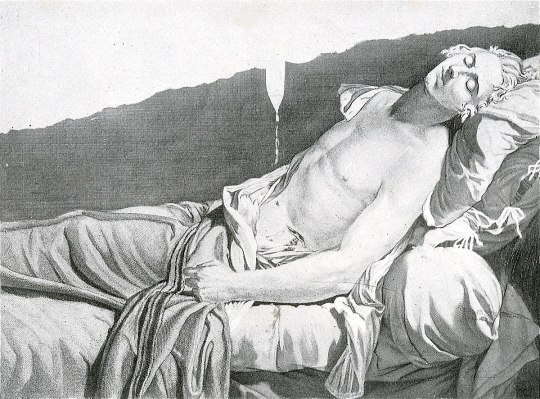
(This image is an engraving of the actual painting, which has gone missing)
After Marat on July 13 1793 (the very same day the plan for public education Lepeletier had been working on was presented to the Convention by Robespierre) became the second assassinated Convention deputy, we find several engravings etc, depicting the two ”martyrs of liberty” side by side.




In the following months, even more people would be join the two, such as Joseph Chalier, a lyonnais politician executed on July 17 1793 and Joseph Bara, a fourteen year old republican drummer boy killed in the Vendée by the pro-Monarchist forces.

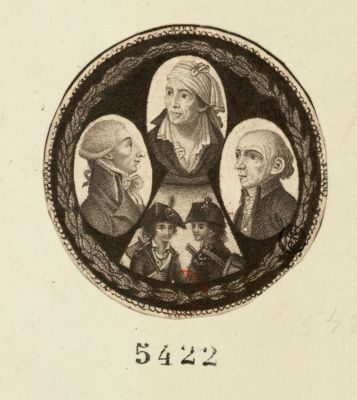


Lepeletier’s murderer, 27 year old Philippe Nicolas Marie de Pâris, a man who the minister of justice described as "former king's guard, height five pieds, five pouces, barbe bleue, and black hair; swarthy complexion, fine teeth, dressed in a gray cloak, green lapels and a round hat” on January 21, went into hiding right after his deed. In spite of his description being published in the papers and a considerable sum of money being promised to whoever caught him, Pâris managed to flee Paris and settled for a country house of an acquaintance near Bourget. He there ran into a cousin of one of the owners. When Pâris asked for food and a bed, he was refused and instead disappeared into the night again. In the evening of January 28 he arrived in Forges-les-Eaux and stopped at an inn, where he came under suspicion once he started cutting his bread with a dagger after which he locked himself into his room. The following morning he woke up with a start as five municipal gendarmes came bursting into his room and told him to come with them. Pâris responded that he would, but in the next second he had picked up his hidden pistol, placed it into his mouth, and pulled the trigger. Searching the dead body, the gendarmes found Pâris’ baptism record (dated November 12 1765) and dismissal from the king's guard (dated June 1 1792), on the latter of which had been written the following:
My certificate of honor. Do not trouble anyone. No one was my accomplice in the fortunate death of the scoundrel de Saint-Fargeau. Had I not run into him, I would have carried out a more beautiful action: I would have purged France of the patricide, regicide and parricide d’Orléans. The French are cowards to whom I say:
Peuple dont les forfaits jettent partout l'effroi,
Avec calme et plaisir j'abandonne la vie.
Ce n'est que par la mort qu'on peut fuir l'infamie
Qu'imprime sur nos fronts le sang de notre roi.
Signed by Paris the older, guard of the king, assassinated by the French.
Learning about what had happened, the Convention tasked Tallien and Legrand with going to Forges-les-Eaux and making sure the dead man really was Pânis. Having come to the conclusion that this was indeed the case, the deputies briefly discussed whether the body ought to be brought back to Paris, but it was decided it would be better if it was just buried "with ignominy.” It was therefore instead taken into the nearby forest in a wheelbarrow and thrown into a six feet deep hole.
Finally, here are some other revolutionaries simping for honoring Lepeletier’s memory just because I can:
…a tragic event took place the day before the execution [of the king]. Pelletier, one of the most patriotic deputies, and who had voted for death, was assassinated. A king's guard made a wound three fingers wide with a saber: he died this morning. You must judge the effect that such a crime has had on the friends of liberty. Pelletier had an income of six hundred thousand livres; he had been président à mortier in the Parliament of Paris; he was barely thirty years old; to many talents, he added the most estimable of virtues. He died happy, he took to his grave the idea, consoling for a patriot, that his death would serve the public good. Here then is one of these beings whom the infamous cabal who, in the Convention, wanted to save Louis and bring back slavery, designated to the departments as a Maratist, a factious, a disorganizer... But the reign of these political rascals is finished. You will see the measures that the Assembly took both to avenge the national majesty and to pay homage to a generous martyr of liberty.
Philippe Lebas in a letter to his father, January 21 1793
Ah! if it is true that man does not die entirely and that the noblest part of himself survives beyond the grave and is still interested in the things of life, come then, dear and sacred shadow, sometimes to hover above the Senate of the nation that you adorned with your virtues; come and contemplate your work, come and see your united brothers contributing to the happiness of the homeland, to the happiness of humanity.
Marat in number 105 (January 23 1793) of Journal de la République Française
O Lepeletier! Your death will serve the Republic: I envy your death. You ask for the honors of the Pantheon for him, but he has already collected the prize of martyrdom of Liberty. The way to honor his memory is to swear that we will not leave each other without having given a constitution to the Republic.
Danton at the Convention, January 21 1793
O Le Peletier, you were worthy to die for your homeland under the blows of its assassins! Dear and sacred shadow, receive our wishes and our oaths! Generous citizen, incorruptible friend of the truth, we swear by your virtues, we swear by your fatal and glorious death to defend against you the holy cause of which you were the apostle; we swear eternal war against the crime of which you were the eternal enemy, against the tyranny and treason of which you were the victim. We envy your death and we will know how to imitate your life. They will remain forever engraved in our hearts, these last words where you showed us your entire soul; ”May my death,” you said, “be useful to the homeland, may it will serve to make known the true and false friends of liberty, and I die content.”
Robespierre at the Jacobins, January 23
Wednesday 23 [sic] — We went to Madame Boyer’s to see the procession. I saw the poor Saint-Fargeau. We all burst into tears when the body passed by, we threw a wreath on it. After the ceremony, we returned to my house. Ricord and Forestier had arrived. I was unable to stop my tears for some time. F(réron), La P(oype), Po, R(obert) and others came to dinner. The dinner was quite fun and cheerful. Afterwards they went to the Jacobins, Maman and I stayed by the fire and, our imaginations struck by what we had seen, we talked about it for a while. She wanted to leave, I felt that I could not be alone and bear the horrible thoughts that were going to besiege me. I ran to D(anton’s). He was moved to see me still pale and defeated. We drank tea, I supped there.
Lucile Desmoulins in her diary, January 24 1793
…Pelletier's funeral took place this Thursday as I informed you in my last letter (this letter has gone missing). The procession was immense; it seemed that the population of Paris had doubled, to honor the memory of this virtuous citizen. The mourning of the soul was painted on all the faces: it was especially noticed that the people were extremely affected, which proves that they keenly felt the price of the friend they had lost. Arriving at the Pantheon, Lepelletier's body was placed on the platform prepared for it; his brother delivered a speech which was applauded with tears; Barère succeeded him. Then the members of the Convention, crowding around the body of their colleague, promised union among themselves, and took an oath to save the country. God grant that we have not sworn in vain, that we finally know the full extent of our duties, and that we only occupy ourselves with fulfilling them! In yesterday's session, Pelletier's daughter, aged eight [sic], was presented to the National Convention, which immediately adopted her as a child of the homeland.
Georges Couthon in a letter written January 26 1793
How could I be so base as to abandon myself to criminal connections, I who, in the world, have never had more than one close friend since the age of six? (he gestures towards David's painting). Here he is! Michel Lepeletier, oh you from whom I have never parted, you whose virtue was my model, you who like me was the target of parliamentary hatred, happy martyr! I envy your glory. I, like you, will rush for my country in the face of liberticidal daggers; but did I have to be assassinated by the dagger of a republican!
Hérault de Sechelles at the Convention, December 29 1793
For a collection of Lepeletier’s works, see Oeuvres de Michel Lepeletier Saint-Fargeau, député aux assemblées constituante et conventionnelle, assassiné le 20 janvier 1793, par Paris, garde du roi (1826)
#hérault and lepeletier being bffs since age six was new information for me#also i think Augustin just found a rival in ”most loyal little bro in the revolution”#frev#michel lepeletier#lepeletier de saint-fargeau#french revolution#ask#long post
63 notes
·
View notes
Text

An American soldier from Comp. B, 68th Arm. Inf. Bn., 4th Arm. Div., engages German snipers entrenched in a spire of the church of Saint-Michel, while the tank in the foreground provides supporting fire in Place de l'Église, Oberhoffen-sur-Moder, Bas-Rhin, Alsace, France. 6 Feb 1945
73 notes
·
View notes
Note
Propaganda for Michel Ney:
This man. THIS MAN HAD SO MUCH CHARACTER. HE’S LITERALLY THE KIND OF MAN THAT INSPIRES GOOD FICTIONAL CHARACTERS NGL!! Since he’s up against a british person, here is a description of him by the Times of London:
“... his name rendered illustrious by 25 years of eminent services and brilliant exploits, was dear to the country, and even the enemies of France admired in him the character of the Great Captain. All allowed him to possess as much generosity of sentiment as bravery and skill at the head of armies. No trait of weakness, adulation or rapacity, had ever cast shade over his loyalty and military virtues. His sole defect seemed to be a certain vehemence of character and expression, which rendered him little suited to public affairs.”
And his death was so tragic. In Waterloo, he had made a fatal mistake with the cavalry, and he decides here that he will die. We don’t know exactly what happened here. Did he have so much PTSD from russia and years of war that he made such a stupid mistake (AA ALSO AFTER the disaster of russia campaign he isolated himself so much. Poor man🥺)? But one thing’s for sure, this man wasn’t a coward. The Bravest of the Brave was not a man who’d mess up in the war and just run away. On those grassy fields, Ney tried everything to get his men’s attention and when all hope seemed lost he shouted in the faces of the enemies “See how a marshal of France meets his death!” It seems in that moment his greatest want was to be killed by english bullets. But Victor Hugo recounts this and adds the ironic line of “Unhappy man, thou wert reserved for French bullets!”
…😭😭😭😭ISN’T THAT JUST…. SO POETIC AND TRAGIC?????
AND DON’T EVEN. DONT EVEN GET ME STARTED ON HOW HE DIED!!!!
This man sobs afterwords he gets tried for treason against france basically for siding with Napoleon. But with how unfairly they zero-in on ney’s wrong doings, this was a blood sacrifice. To help him, his lawyer reasoned that the place Ney was born from technically was no longer french, since it has been annexed by Prussia from the 1815 treaty of paris…
But this guy. OH nOnoNonononononoNO, this red-haired, lion-looking, emotional honor-filled patriot has the audacity to interrupt his defender and say loudly without the slightest doubt or hesitation "I am French and I will remain French!"
….
Come on. COME ON!!!! How stupid is he???!! How idiotic!! He just closed another door to survival because of what??
because of honor….. Wow, can you imagine that? He has given everything all his years of service, all his years of being a husband, a father, a son, all his years of rest and peace of mind to France. He has done so much, and even when…EVEN WHEN FRANCE SLAPS HIM ACROSS THE FACE AND SAYS “you traitor” He shouts back “I am French and I will remain French!” aaaaaaAAAAAAAAAAAAAAAA OMG….. what the hek…who is this man????
So he is executed as a traitor. There are different versions of his death but here are a few:
By Rochechouart:
“He [Ney], of course, refused to kneel down and be blind-folded; he merely asked the Commandant Saint-Bias to show him where he should stand. He stood facing the platoon, who held their guns ready to fire. Then, in an attitude I shall never forget, it was so noble, calm and dignified, without bravado, he took off his hat, and availing himself of the moment when the Adjutant stepped aside and gave the signal to fire, he said these words, which I distinctly heard: Frenchmen, I protest against my sentence; my honour..." As he said these words he placed his hand on his heart; the volley was fired, and he fell. A rolling of drums, and the shout of "Vive le Roi" from the surrounding troops closed the mournful ceremony.”
Such a death made a deep impression on me, and turning to Auguste de la Rochejaquelein, Colonel of the Grenadiers, who was beside me, and who, like me, deplored the death of the bravest of the brave, I said: ‘There, my dear friend, is a lesson how to die.’”
By M. Laisne:
“He [Ney] took some steps, removed his hat, and in a loud and clear voice: ‘I protest,’ he said ‘before heaven and mankind, that the judgment that condemns me is iniquitous; I appeal from it to Europe and to posterity’ …. Before these words there was presented to him a handkerchief to bandage his eyes. He answered with exaltation, ‘do you not know that a soldier does not fear death.’ He advanced again four paces, laying his hand on his heart and said to the soldiers: ‘Do your duty. It is there that you must hit, do not miss me.’ Instantly he fell dead.”
And finally a very close person to him, Ida Saint-Elme:
“Ney got out of the carriage. He was wearing civilian clothes: a long dark coat, a white necktie, black breeches and stockings, a tall beaver hat with curved brim. He uncovered. His slightly raised head showed that his face wore a tranquil expression. He looked first to the right and then to the left. He caught sight of me. Then, as though fearing to compromise his faithful friends by the least sign of recognition, he bent his brow downward a trifle.”
“He walked on with firm step. At that instant I discerned through the mist, in the centre of the square of troops, and standing out from the dark background of the wall, the firing squad. I tried to rush forward. Belloc pulled me back, and forced me into the cab.”
“Then I dropped weakly upon the seat. A few minutes elapsed, each a whole century long. Then I heard a sharp report. I went into a dead faint."
His death is so tragic and amazing. It really shows out his character and was the initial thing that got me interested in him as a person. Anyways, basically, this dude is such a tragic glory-lover but also very heroic and inspiring.
So therefore HE ISS SEXY GO VOTE FOR NEY!!!
.
27 notes
·
View notes
Note
how does it feel to live in France
honestly the fact that i can just take my car and go to such places fill me with a joy indescribable. while i adore travelling i also find such beauty in the close things
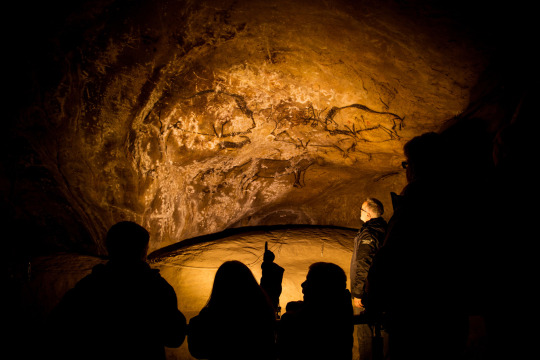
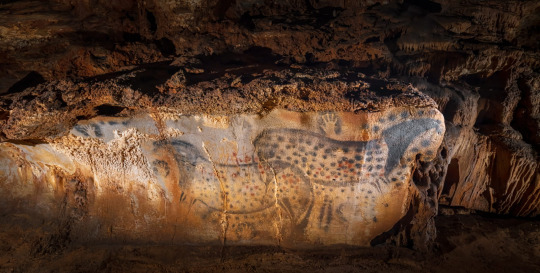
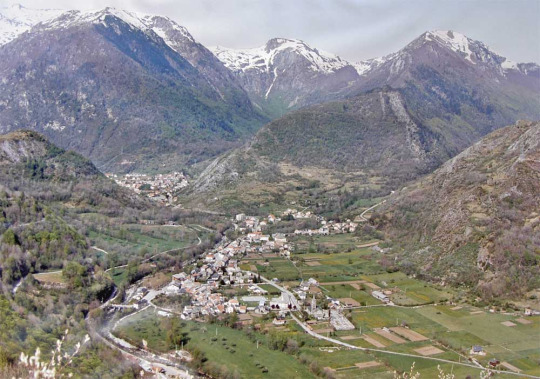
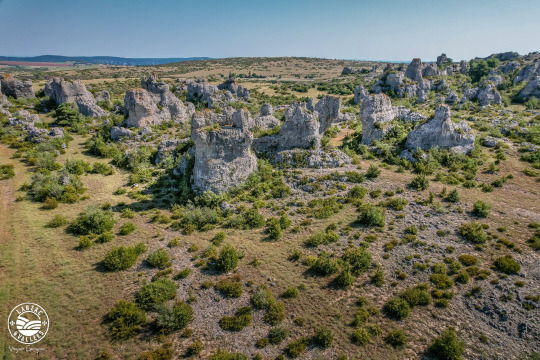

it's also a country with a goofy ass government always had had one that has never made peace with & gone forward with reparations for its colonial past and refuses to look in the eye its current colonial present. it gets surprised that a "french territory" that has had independentist decolonial movements for centuries might actually mean it for real. pretends-it-does-not-see.jpg centuries of colonial oppression of northern africa and the still-felt retombées of last century's war-waging in the region & then dares point a finger at northern african immigrants (the accusatory finger of the populist, like a compass always points north, will always find a minority to blame) to pin the current social crises on them.
it's also not the socialist utopia so many american leftists seem to believe it is¹ and it's like seeing a puppet stuffed with french name to see this fantasy paraded online for real. yes we protested for months when they wanted to raise the age of retirement & stuff was burned. they still passed the law. because there exist in the french legal system that allows to pass a law regardless of if the people don't want it & the governing bodies don't want it.
well we know what the next step is... shrug emoji [pour des raisons légales ceci n'est pas une menace]
¹ i love to not pay multiple thousands for an ER visit because of a broken finger though i do.
anyways. of the best things we have here i can offer the profiteroles (pastry puffs with vanilla ice cream and hot chocolate on top)

the przewalski horses on the méjean

and the view into the gorges from l'Érmitage Saint-Michel 🍸

#come to my country. never go to paris not worth it. come in the south it's nice#ring ring (answers)#anonymous
43 notes
·
View notes
Text

After some research, I was able to find out where all of the princesses are from. Here are my notes…
Snow White: Snow White was first published in Germany by the Brothers Grimm, in 1812, in their book Grimm's Fairy Tales. Because of this I assume the Disney version is from Germany.
Cinderella: Cinderella takes place in France and it is based on the French fairy tale by Charles Perrault, it says so in the credits. More proof is that all of the women at the ball have French names and Cinderella’s house is referred to as Château which is a french word.
Aurora: The French symbol the Fleur-de-lys can be found everywhere in the castle and in the credits. Plus, the credits it says the movie is based on the Charles Perrault version of Sleeping Beauty.
Ariel: Ariel is from Atlantica which is a kingdom that is located somewhere in the Mediterranean Sea. This is confirmed on Disney Wiki "Eric's Castle is located on the shore of a Mediterranean-like country". The official Disney Princess youtube channel has a video titled: Fun Facts About Ariel! How Many Do You Know? | Disney Princess, where it says that Ariel grew up in the Mediterranean and specifies that Eric’s caste is in Italy.
Belle: The movie literally says that it is set in France.
Jasmine: Ron Clements and John Musker, the directors of the film said that the movie was originally intended to be set in Baghdad, Iraq. However, it was changed to the fictional city of Agrabah during production due to the Gulf War in the early 1990s. Here is part of the interview: “We kept it Baghdad in our first treatment, and then the Gulf War happened […] This can't be in Baghdad. So, I took letters and did a jumbled anagram and came up with Agrabah, Musker told E! News." Agrabah is an adaptation of Baghdad.
Pocahontas: The movie starts off with “In sixteen hundred seven We sail the open sea For glory, God, and gold And the Virginia Company”.
Mulan: It says so in the movie that it is set in China.
Tiana: The movie says that it takes place in New Orleans.
Rapunzel: In the TV show a satellite shot can be seen showing that Corona is located in central France. Mont Saint-Michel and Rocamadour (France) where some of the inspirations behind the kingdom. The video A Tangled World: Creating the Look on the Walt Disney Animation Studios YouTube channel explains that the executive producer wanted to make Rapunzel’s tower look like “the most charming B and B in the south of France”.
Merida: Scotland obvious clues in movie.
Moana: I guessed Samoa because she wears a Samoan-inspired ceremonial dress at one point in the movie. The song “We Know the Way” features more lyrics in Samoan than other Polynesian languages, and Motunui, the fictional island of the film, mostly drew inspiration from elements of the real-life island nations of Fiji, Samoa, and Tonga.
Anna and Elsa: Arendelle was based on multiple locations in Norway. The team behind Frozen visited Norway to gain inspiration, and you can see Nordic influence all throughout the movie.
Raya: It's difficult to figure out one specific country since Kumandra is based on multiple Southeast Asian countries.
#disney#snow white#cinderella#charles perrault#nationality#disney princess#aurora#ariel#belle#jasmine#pocahontas#mulan#tiana#rapunzel#merida#moana#anna and elsa#raya
23 notes
·
View notes
Text

Un débarcadère au coin de la place Saint-Michel lors de la grande crue de la Seine en janvier 1910.
26 notes
·
View notes
Text
My list of favorites and their birthdays for no reason whatsoever.
Gilbert von Obsidian (IkePri): 12/21 (Sagittarius)
Akaza (OlySoi): 8/9 (Leo)
Clavis Lelouch (IkePri): 6/17 (Gemini)
Vlad (IkeVamp): 6/6 (Gemini)
Chevalier Michel (IkePri): 11/1 (Scorpio)
Licht Klein (IkePri): 10/9 (Libra)
Dazai Osamu (IkeVamp): 6/19 (Gemini)
Dante Falzone (Piofiore): 9/17 (Virgo)
Kanetsugu Naoe (IkeSen): 8/1 (Leo)
Kenshin Uesugi (IkeSen): 2/18 (Aquarius)
Sasuke Sarutobi (IkeSen): 4/10 (Aries)
Edgar Bright (IkeRev): 8/23 (Virgo)
Silvio Ricci (IkePri): 7/23 (Leo)
Leon Dompteur (IkePri): 8/1 (Leo)
William Shakespeare (IkeVamp): 11/11 (Scorpio)
Himuka (OlySoi): 8/8 (Leo)
Jean d'Arc (IkeVamp): 1/6 (Capricorn)
Kyle Ash (IkeRev): 7/17 (Cancer)
Rio Ortiz (IkePri): 4/13 (Aries)
Keith Howell (IkePri): 2/20 (Pisces)
Mitsuhide Akechi (IkeSen): 10/4 (Libra)
Kicho: 11/15 (Scorpio)
Fenrir Godspeed (IkeRev): 4/15 (Aries)
Saint-Germain (C:R): 8/2 (Leo)
Victor Frankenstein (C:R): 8/26 (Virgo)
William Rex (IkeVil): 4/24 (Taurus)
Yukimura Sanada (IkeSen): 7/7 (Cancer)
Ray (MysMes): 6/11 (Gemini)
Monshiro (PotBB): 7/7 (Cancer)
Charles-Henri Sanson (IkeVamp): 2/15 (Aquarius)
Yves Kloss (IkePri): 9/16 (Virgo)
Lancelot Kingsley (IkeRev): 1/11 (Capricorn)
Hikage (PotBB): 1/1 (Capricorn)
Harr Silver (IkeRev): 12/12 (Sagittarius)
Riku (OlySoi): 7/15 (Cancer)
Sirius Oswald (IkeRev): 5/7 (Taurus)
Leon (SCM): (Leo)
Jumin Han (MysMes): 10/5 (Libra)
Ichiya Mitsumori (VariBarri): 7/13 (Cancer)
Scorpio (SCM): (Scorpio)
Taiga Isurugi (VariBarri): 12/3 (Sagittarius)
Loki Genetta (IkeRev): 2/22 (Pisces)
Il Fado de Rei (CE): 7/7 (Cancer)
Orlok (Piofiore): 4/23 (Taurus)
Heudhaut (SCM): (Aquarius)
Victor (IkeVil): 2/20 (Pisces)
Ellis Twilight (IkeVil): 7/4 (Cancer)
Elbert Greetia (IkeVil): 1/27 (Aquarius)
Liam Evans (IkeVil): 9/6 (Virgo)
Alfons Sylvatica (IkeVil): 8/8 (Leo)
Jin Grandet (IkePri): 3/5 (Pisces)
Masamune Date (IkeSen): 9/5 (Virgo)
I know the list is long! I love a lot of 2D men. These are only the ones I'd buy merchandise for, so... that's telling you something about my hobby. Color-coded by how much I adore them. Most other characters fall into the next category, which is merch that I'd collect, but not seek out on its own or buy without someone else in the list.
Grand total of loves in each sign
Leo: 8
Cancer: 7
Virgo: 6
Sagittarius: 4
Gemini: 4
Scorpio: 4
Aquarius: 4
Pisces: 4
Aries: 3
Libra: 3
Taurus: 3
Capricorn: 3
Turns out I like Leos the most and subsequently fire signs at 15. This is tied with water signs at 15 and Cancers taking up second place. Virgo is my third favorite sign with earth clocking in at 12. And strangely, air signs only hit 11, which I thought would be my most loved kind since I tend to like Gemini characters, but I guess not.
8 notes
·
View notes
Note
As a French I was not impressed with DD, it's mostly an americanized vision of France that relies heavily on its scenery.
💯 I'm not French and I wasn't impressed either. I wanted to love it because French culture and history would lend themselves to some unique post-apocalyptic stories, but instead there was a dissonance of watching French people in a very American narrative, set in France.
When Norman said he was proud they've avoided the striped shirts, baguettes and berets, it felt like that's setting a really low bar for yourself. They still used every stereotype that Americans imagine to be quintessentially French. Zabel doesn't seem to have any specialized knowledge or ties to France—the extent of his awareness might be Napoleon, the Great War and WWII, so I was deeply saddened by the squandered potential.
The characters mention the Eiffel Tower in every episode, as if Paris and France as a whole doesn't have a myriad of monuments that are imbued with the proper je ne sais quoi to represent the country. For the purposes of the external plot—the ‘political’ one, involving Mme Genet—the Arc de Triomphe might've been better as it's associated with both the Nazis marching down the Champs-Élysées and the liberation of Paris. Zabel seems enamored with war imagery and the story is one of oppression, so it fits. Using the Eiffel Tower as a shorthand stand-in for ‘all things French’ is lazy writing and also communicates a fundamental misunderstanding of French people.
Genet would've grown up in Mitterrand's France and been shaped by the cultural undercurrents of that time (he was the longest serving French president, from early 80s to mid-90s) and instead she acts like an American militia leader in one of the sparsely populated western states in the US. She's a post-apocalyptic politician, but she has more in common with Deanna and Pamela and their Midwestern sensibilities than with anything resembling French politics.
The cinematography of DD is beautiful because France is very photogenic, but the storytelling isn't grounded in the setting. Zabel could've told the same story anywhere that has beautiful vistas because nothing about the plot requires the show to be set in France. It's like he didn't ask himself, "what kind of plot can I build that would really showcase Mont-Saint-Michel?" It's just a prop: ‘the Nest’ could be any place, even flats built inside a soundstage, because Zabel's not using any of its unique properties to create an exciting plot, or even enhance the mood/ambiance. The unimaginative yellow wash palette of the show goes perfectly with the generic American Savior narrative 😬 Setting needs to shape and inform the plot. It's integral to its themes and the imagery you choose to tell the story.
Zabel tells the story of American incursions in France, e.g. Daryl's grandfather and the loony expat who was hoarding resources, but it's not a story centered on France. The gaze is a distinctly American.
13 notes
·
View notes
Text
The ordinary practitioners of the city live "down below," below the thresholds at which visibility begins. [...] [T]he everyday has a certain strangeness [...]. The city serves as a totalizing and almost mythical landmark for [modernist, imperialist] socioeconomic and political strategies [and ideologies] [...]. The Concept-city is decaying. [...] [But there remains] practices which [...] [this powerful] system was supposed to administer or suppress, but which have outlived [...]. Their story begins on ground level, with footsteps. [...] Their intertwined paths give their shape to places. They weave places together. [...] [T]he city itself [can seem to be] an immense social experience of lacking a place [...]. Numbered streets and street numbers (112th St., or 9 rue Saint-Charles) [...] orders of identities [...], constellations that hierarchize and semantically order the surface of the [landscape] [...]. [But] stories and legends [...] haunt urban space [...]. It is through [...] their capacity to create cellars and garrets everywhere, that local legends [...] permit exits, ways of going out and coming back in, and thus habitable spaces. [...] Stories about places are makeshift things. They are composed with the world’s debris. [...] [The hegemonic] order is everywhere punched and torn open by ellipses, drifts, and leaks of meaning [...]. [People, through stories and engagement with landscape, can] produce effects of dissimulation and escape [...]. Objects and words also have hollow places in which a past sleeps, as in the everyday acts of walking, eating, going to bed, in which ancient revolutions slumber. [...] “Memories tie us to that place. [...] [T]hat’s what gives a neighborhood its character.” There is no place that is not haunted by many different spirits hidden there in silence, spirits one can “invoke” or not. Haunted places are the only ones people can live in -- and this inverts the schema of the Panopticon.
Text by: Michel de Certeau. "Walking in the City". The Practice of Everyday Life. 1980. As translated by Steven Rendell, 1984.
---
[W]hat has to be forgotten to make things [legible to hegemonic systems] [...], the survivals of other ways of thinking that creep in as ‘lapses in the syntax created by the law [...]’ where ‘they symbolize a return of the repressed [...].’ [L]ook at the authority mechanisms through which speech is credentialised [...]. The propre creates objects through transforming the uncertainties of history into readable spaces [...]. These are the ruins of non-hegemonic systems [...]. Instead he seeks a mode of knowledge through travel to open space to difference [...]. Stories are not about movement, but make movements, not objects but effects, they transform [...]. [R]eading, narrating and speaking. Where ‘pedestrian utterances’ [engaging, commuting, interacting with the landscape] speak the city [...]. [S]pace is practised place. [...] The gaze of power transfixes objects but also thus becomes blind to a vast array of things that do not fit its categories. [...] Control of space is a matter of strategy which is orientated through the construction of proper knowledge. In contrast, there are tactics -- the arts of making do, like reading, or cooking -- which use what is there in multiple permutations. This practical knowledge of the city [or other types of places] transforms and crosses spaces, creates new links [...], comprising mobile geography of looks and glances. A crucial well spring is memory. [...] The alterity is that these memories contain not just events, but still carry the remains of different conceptual systems from whence they came. These then are the ghosts in the machine. Walking [moving, exploring, engaging] is to create [...] haunted geographies.
Text by: Mike Crang. “Relics, places and unwritten geographies in the work of Michel de Certeau (1925-86).” In: Thinking Space. 2000.
#halloween#i guess idk#ecology#abolition#imperial#colonial#haunted#indigenous#multispecies#landscape
28 notes
·
View notes
Photo

1963 à Paris, Place Saint-Michel, vieux autobus, mais aussi des anciens taxis G7. - source John d'Orbigny Immobilier.
84 notes
·
View notes
Text

Le Petit écho de la mode, no. 16, vol. 15, 23 avril 1893, Paris. 13. Robe de créponné glacé rose et mauve. Modèle de Mlle Thirion, 47, boulevard Saint-Michel. 15. Robe d'épinglé beige changeant sur vert. Modèle de Mme De Mirebourg, 40, rue de Provence. Ville de Paris / Bibliothèque Forney
(13.) Robe de créponné glacé rose et mauve. — La jupe entourée de trois volants plissés avec têtes formées par des liens de soie pensée noués de place en place. Corsage légèrement drapé sur les épaules. Le décolletage carré formé pas une draperie de soie pensée sur une berthe plissée. Manches mi-longues.
(13.) Pink and mauve glazed creponné dress. — The skirt surrounded by three pleated ruffles with heads formed by ties of thought silk tied from place to place. Bodice lightly draped over the shoulders. The square neckline formed by a silk drapery designed on a pleated berthe. Mid-length sleeves.
Matériaux: 8 mètres de créponné, 10 mètres de soie.
—
(15.) Robe d’èpinglé beige changeant sur vert. — Tunique entourée d’un velours noir, fendue de côté sur un dessous broché bois et beige à reflets bleus. Corsage broché. Manches et grands revers unis avec bord de velours, poignets unis, tous les nœuds en velours comme la bordure, le dos même forme que le devant du corsage.
(15.) Beige pinned dress changing to green. — Tunic surrounded by black velvet, slit on the side on a wooden and beige brocade underside with blue reflections. Paperback bodice. Plain sleeves and large lapels with velvet edge, plain cuffs, all velvet bows like the border, the back same shape as the front of the bodice.
Matériaux: 4m,50 de broché, 10 mètres d’épinglé, 12 mètres de ruban de velours.
#Le Petit écho de la mode#19th century#1890s#1893#on this day#April 23#periodical#fashion#fashion plate#description#Forney#dress#collar#gigot#devant et dos#Modèles de chez#Mademoiselle Thirion#Madame de Mirebourg
61 notes
·
View notes
Text

Then & Now
Edouard Léon Cortès
(1882 - 1969)
Notre Dame, Place Saint Michel
Oil on canvas
13 x 18 inches
Signed
https://rehs.com/Edouard_L%C3%A9on_Cort%C3%A8s_Notre_Dame_Place_Saint_Michel.html
Photograph of Notre Dame taken in 2005.
Notre-Dame Cathedral, situated on the Île de la Cité in the heart of Paris, is a masterpiece of French Gothic architecture and an iconic symbol of the city. Construction of this awe-inspiring cathedral began in 1163 and was completed in the 14th century. Known for its stunning rose windows, intricate sculptures, and flying buttresses, Notre-Dame has captivated visitors with its grandeur for centuries. The cathedral gained worldwide attention, both for its architectural significance and cultural importance, especially with Victor Hugo's novel "The Hunchback of Notre-Dame." Unfortunately, in April 2019, a devastating fire engulfed Notre-Dame, causing extensive damage to its roof and spire. Efforts to restore and rebuild this historical landmark are underway, reflecting a collective commitment to preserving the rich heritage and beauty of Notre-Dame for future generations.
#edouardleoncortes#edouardcortes#Paris#France#notredame#sunset#cityscape#cityscene#buywithrehs#streetscene#art#arte#paintingoftheday#painting#impressionism#hustleandbustle#simplertimes#placestmichel#parisstreetscene#lateafternoon#placesaintmichel#thenandnow
12 notes
·
View notes
Text

{Meet the French Exorcists!}
Aoex has such an extensive universe with so many different True Cross Order branches around the world. Today I want to present to you a couple of high-class Exorcists from France!
Hector Cessart - Upper First Class Exorcist, all meister, speciality: Dagoon & Tamer, principal of the Exorcist Academy of France, also located in Paris.
Joseph Aury - Former Paladin, now Chancellor (Honorary Knight), all meisters, speciality: Aria, leader of the French True Cross branch (HQ located on Le Mont-Saint-Michel) until he died in the Blue Night
Joséphine Legouix - Upper First Class Exorcist, all meisters, speciality: Knight & Doctor. One of the leading experts when it comes to complicated demonic possessions of human bodies. Her own sword is possessed by a powerful demon from the Gargoyle-category with whom she has a blood pact.
Ophélie de Lys - Upper First Class Exorcist, all meisters, speciality: Tamer & Aria, Member of the Demonic Members Control Office and student of Pater Chevalier. She takes his place as Arc Knight and Head of the Control Office after his death.
Augustin Chevalier - Arc Knight, all meisters, worldwide known Tamer expert, Head of the Demonic Members Control Office within the True Cross Order until he dies due to a possession by Satan.
Oriax - No Title, no meister, yet he is the guardian of the great library of the True Cross Order Europe, located under Notre Dame in Paris. Since decades he serves as a librarian and historian in the most extensive collection of exorcist & demon records in the world. He is a Nephilim and son of the Demon King Lucifer.
35 notes
·
View notes